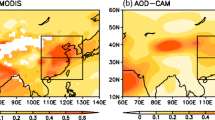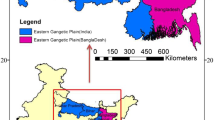Abstract
We investigated the regional-scale relationships between columnar aerosol loads and summer monsoon circulation, and also the precipitation over northeast Asia using aerosol optical depth (AOD) data obtained from the 8-year MODIS, AERONET Sun/sky radiometer, and precipitation data acquired under the Global Precipitation Climatology Project (GPCP). These high-quality data revealed the regional-scale link between AOD and summer monsoon circulation, precipitation in July over northeast Asian countries, and their distinct spatial and annual variabilities. Compared to the mean AOD for the entire period of 2001–2008, the increase of almost 40–50% in the AOD value in July 2005 and July 2007 was found over the downwind regions of China (Yellow Sea, Korean peninsula, and East Sea), with negative precipitation anomalies. This can be attributable to the strong westerly confluent flows, between cyclone flows by continental thermal low centered over the northern China and anticyclonic flows by the western North Pacific High, which transport anthropogenic pollution aerosols emitted from east China to aforementioned downwind high AOD regions along the rim of the Pacific marine airmass. In July 2002, however, the easterly flows transported anthropogenic aerosols from east China to the southwestern part of China in July 2002. As a result, the AOD off the coast of China was dramatically reduced in spite of decreasing rainfall. From the calculation of the cross-correlation coefficient between MODIS-derived AOD anomalies and GPCP precipitation anomalies in July over the period 2001–2008, we found negative correlations over the areas encompassed by 105–115°E and 30–35°N and by 120–140°E and 35–40°N (Yellow Sea, Korean peninsula, and East Sea). This suggests that aerosol loads over these regions are easily influenced by the Asian monsoon flow system and associated precipitation.
Similar content being viewed by others
References
Adler, R. F., and Coauthors, 2003: The version-2 global precipitation climatology project (GPCP) monthly precipitation analysis (1979-present). J. Hydrometeor., 4, 1147–1167.
Bollasina, M., S. Nigam, and K.-M. Lau, 2008: Absorbing aerosols and summer monsoon evolution over south Asia: an observational portrayal. J. Climate, 21, 3221–3239.
Huebert, B. J., T. Bates, P. B. Russell, G. Shi, Y. J. Kim, K. Kawamura, G. Carmichael, and T. Nakajima, 2003: An overview of ACE-Asia: strategies for quantifying the relationships between Asian aerosols and their climatic impacts. J. Geophys. Res., 108(D23), 8633, doi:10.1029/2003JD003550.
Huffman, G. J., R. F. Adler, P. Arkin, A. Chang, R. Ferraro, A. Gruber, J. Janowiak, A. McNab, B. Rudolf, and U. Schneider, 1997: The global precipitation climatology project (GPCP) combined precipitation dataset. Bull. Amer. Meteor. Soc., 78, 5–20.
Intergovernmental Panel on Climate Change (IPCC), 2007: Climate Change 2007: The Physical Science Basis. Contribution of Working Group I to the Fourth Assessment Report of the Intergovernmental Panel on Climate Change, Solomon, S., D. Qin, M. Manning, Z. Chen, M. Marquis, K. B. Averyt, M. Tignor, and H.L. Miller. Eds., Cambridge University Press.
Kim, S.-W., S.-C. Yoon, J. Kim, and S.-Y. Kim, 2007: Seasonal and monthly variations of columnar aerosol optical properties over east Asia determined from multi-year MODIS, LIDAR and AERONET sun/sky radiometer measurements. Atmos. Environ., 41, 1634–1651.
_____, ______, E. G. Dutton, J. Kim, C. Wehrli, and B. N. Holben, 2008: Global surface-based sun photometer network for long-term observations of column aerosol optical properties: intercomparison of aerosol optical depth. Aerosol Sci. Technol., 49, 1–9.
Kistler, R., E., and Coauthors, 2001: The NCEP-NCAR 50-year reanalysis: monthly means CD-ROM and documentation. Bull. Amer. Meteor. Soc., 82, 247–268.
Lau, K. M., and K. M. Kim, 2006: Observational relationships between aerosol and Asian monsoon rainfall, and circulation. Geophys. Res. Lett., 33, L21810, doi:10.1029/2006GL027546.
_____, M. K. Kim, and K. M. Kim, 2006: Asian monsoon anomalies induced by aerosol direct effects. Climate Dyn., 26, 855–864, doi: 10.1007/s00382-006-0114-z.
Li, Z., and Coauthors, 2007: Aerosol optical properties and their radiative effects in northern China. J. Geophys. Res., 112, D22S07, doi:10.1029/2006JD007382.
Mahowald, N. M., and L. M. Kiehl, 2003: Mineral aerosol and cloud interactions. Geophys. Res. Lett., 30, 1475.
Menon, S., J. Hansen, L. Nazarenko, and Y. Luo, 2002: Climate effects of black carbon aerosols in China and India. Science. 297, 2250–2253.
Nakajima T., and Coauthors, 2007: Overview of the atmospheric brown cloud east Asian regional experiment 2005 and a study of the aerosol direct radiative forcing in east Asia. J. Geophys. Res., 112, D24S91, doi:10.1029/2007JD009009.
Quaas, J., and O. Boucher, 2005: Constraining the first aerosol indirect radiative forcing in the LMDZ GCM using POLDER and MODIS satellite data. Geophys. Res. Lett. 32, L17814.
_____, ______, and F. Breon, 2004: Aerosol indirect effects in POLDER satellite data and in the LMDZ GCM. J. Geophys. Res., 109, D08205.
_____, ______, and U. Lohmann, 2006: Constraining the total aerosol indirect effect in the LMDZ and ECHAM4 GCMs using MODIS satellite data. Atmos. Chem. Phys., 6, 947–55.
Ramanathan, V., and Coauthors, 2001: The Indian Ocean experiment: an integrated assessment of the climate forcing and effects of the great Indo-Asian haze. J. Geophys. Res., 106, 28371–28399.
_____, and Coauthors, 2005: Atmospheric brown clouds: impacts on South Asian climate and hydrological cycle. Proc. Natl. Acad. Sci., 102, 5326–5333.
United Nations Environment Programme (UNEP), 2008: Atmospheric Brown Clouds: Regional Assessment Report with Focus on Asia. 354 pp.
Zhou, Y., S. Gao, and S. Shen, 2004: A diagnostic study of formation and structures of the Meiyu Front System over East Asia. J. Meteor. Soc. Japan, 82, 1565–1576.
Author information
Authors and Affiliations
Corresponding author
Rights and permissions
About this article
Cite this article
Yoon, SC., Kim, SW., Choi, SJ. et al. Regional-scale relationships between aerosol and summer monsoon circulation, and precipitation over northeast Asia. Asia-Pacific J Atmos Sci 46, 279–286 (2010). https://doi.org/10.1007/s13143-010-1002-3
Received:
Revised:
Accepted:
Published:
Issue Date:
DOI: https://doi.org/10.1007/s13143-010-1002-3




